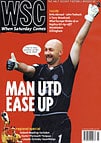 Gary Oliver on a breakaway "SPL2" becoming reality
Gary Oliver on a breakaway "SPL2" becoming reality
The skewed values of Scotland’s sports editors were never more apparent than on January 18. While back pages devoted inordinate space to Stan Collymore’s declared interest in joining Celtic, in most papers the day’s most important football story was tucked away near the racing form. And the hot tip there was that soon the Scottish Football League would be further weakened by yet another breakaway.
The previous day representatives from seven First Division clubs – Livingston, Falkirk, Clyde, Airdrie, Inverness, Ross County and Raith – unanimously agreed on the need to leave their “financial no-man’s land” and set up “sooner rather than later” as a second tier of the Premier League. Absent were the three others in the division: part-time upstarts Alloa; Morton, in administration and unable to commit to anything; and, curiously, Ayr Utd, one of the league’s few spending clubs.
“We’re not out to destroy Scottish football,” insisted the mutineers’ spokesman, Dominic Keane, the Livingston chairman. The group’s stated aim, “to protect and promote full-time football”, is of course laudable, but it is rich that a club such as Raith, stony broke thanks to follies by boards past and present, should now berate the SFL for generating insufficient commercial income. Unfortunately, the insurgents seem no longer willing even to try working within the organisation and their resignations seem only a matter of time.
The septet obviously hope that the umbrella of the SPL will provide shelter from financial reality. The creation of an SPL2, thrown scraps from the top table, might conceivably mean a slightly more equitable sharing of TV and sponsorship monies. But in other respects they are rebels without just cause.
In early January Keane claimed a breakaway second tier would “provide a challenge to those above in the SPL”, arguing it is unacceptable that teams in the top league are immune from relegation by dint of the 10,000 seat criterion. Spot on. Yet he has so far given no indication of how his revolt will alter the present state of affairs, in which only three First Division sides are eligible to step up.
The Premier League is certainly not about to alter its door policy. And Keane has said that in his opinion a stadium of no more than 4-5,000 would be required to play in the second tier. So regardless of whether the title is Scottish League Division One, SPL 2 or even The Seven Dwarves’ Breakaway, it would likely remain a league from which the majority could not be promoted. And, if restricted only to sides able to muster, say, 5,000 seats, sensibly run clubs such as Alloa and Stranraer, who at present aspire to occasional seasons in the First Division, are liable to be turned away. SPL2 could quickly become a stagnant pond.
Received wisdom is that the seven will recruit one more club and press for the current 12-team SPL to become two divisions of ten. It had been thought that Partick Thistle, champions-elect of the Second Division, would soon be on-message. But chairman Brown McMaster immediately distanced Thistle from the rebels’ cause: “We are happy in the SFL and could not afford to walk away.”
An eighth member will no doubt be found, but there is no guarantee the escapees will find sanctuary elsewhere. The SPL would first have to compensate the Scottish League should the leavers fail to serve the required two years’ notice. And many clubs in the SPL, an organisation driven by self-interest, may be reluctant to expand further lest it dilutes their income and endangers their status.
According to Keane, the seven secessionists have gone public without any assurances from above and he concedes they must now make a convincing case for being admitted to the SPL. One hopes their arguments for deserting the Scottish Football League are more persuasive than what has been heard so far.
From WSC 169 March 2001. What was happening this month